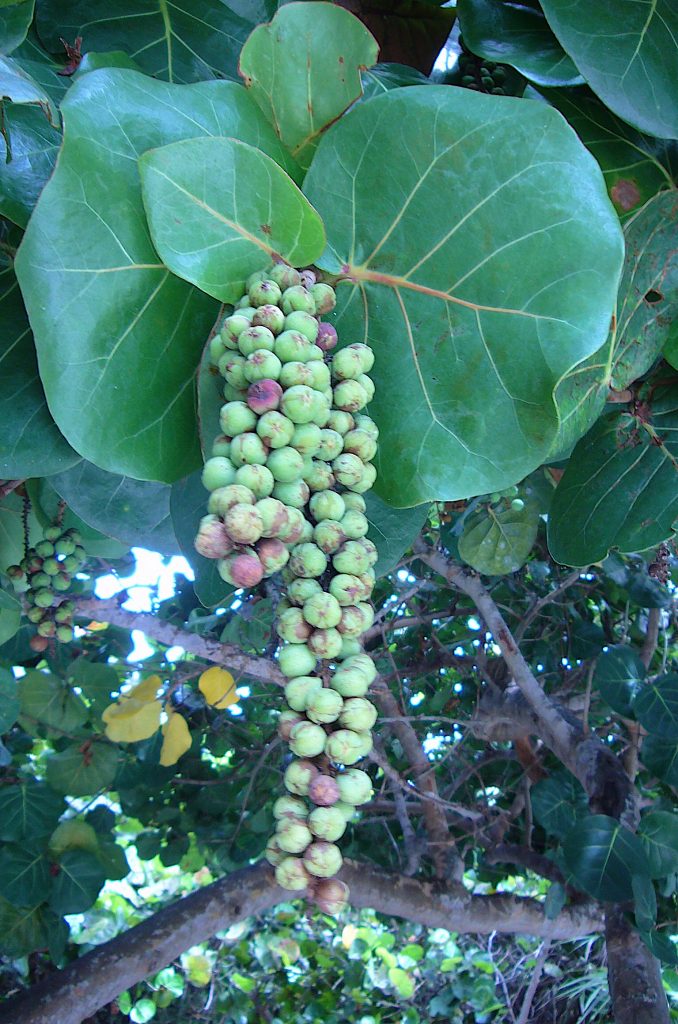
Seagrapes are coming into season. This week near St. Petersburg we got to taste a few, from the tree and off the ground. Sometimes the best fruits are the ones you have to fight the ants for. The only problem with Seagrapes off the ground — if it is a problem — is they can ferment a little and taste a bit zippy, wine-ish. In central Florida Seagrapes are at the northern end of their range. They fair a bit better on the coast but are usually no more than eight or 10 feet high. Further south they attain tree status and near the equator they are huge trees. (Did you know that trees that grow near the equator have no growth rings because they don’t have seasons as in the northern latitudes.) Seagrapes are garnet red color when ripe, and sweet. People mistakenly make them into jelly. It’s a mistake because the jelly tastes so much like apple jelly the Seagrape identity is lost. It’s best to just eat them out of hand. To read more about the Seagrape go here.
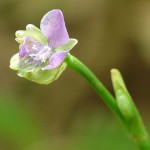
Doveweed, Murdannia, might be the smallest non-floating edible plant in the United States. Barely known, easily overlooked, yet very invasive. It pays to be small. For some young Doveweed is prime for soups, others view it as famine food. I can understand that. It’s closely related to a genus that gives me an upset stomach, the Commelinas (Dayflowers.) I use only Doveweed blossoms in my salad. To anyone used to finding Dayflowers the Doveweed will look familiar but only a few inches tall. It also has a lot of common names around the world including “Micky Mouse.” To read more about the Doveweed, go here.
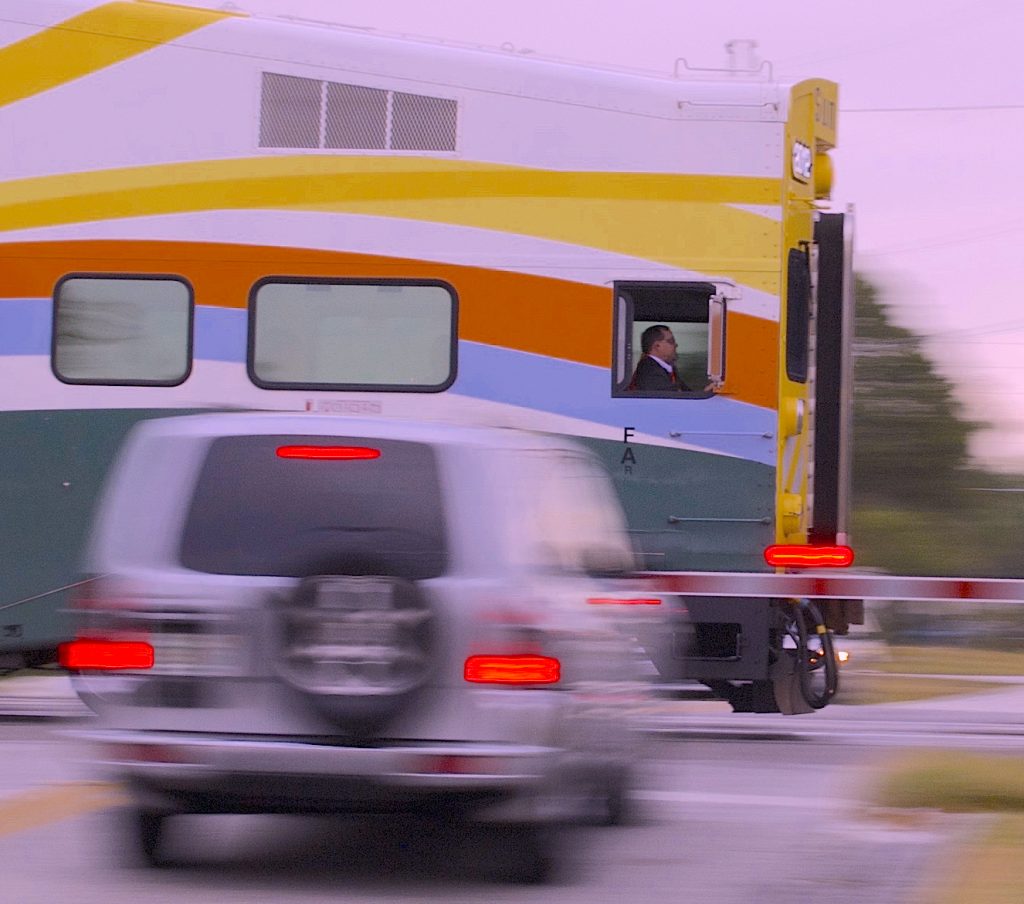
It’s truly irritating to read someone write “never forage within 120 feet of a road.” It’s a non-thinking statement whereas foraging is a thinking activity. I am not aware of any formal research on the road topic so the distance is arbitrary to start with, and who carries a long measuring tape with them? More to the point it misses one of the most important points about foraging and the environment, assessing the lay of the land. Which way might the rain or runoff flow? How about prevailing winds? Is there manure pile nearby, or heavily -sed mega- farm land? Is it a dog park? Am I uphill a little from a country dirt road, or downhill and downwind from a busy interstate? The 120-foot mantra is rather meaningless. What’s more important is looking around. Foraging makes pollution personal. So take it personally. Is the flower bed above the parking lot and watered with city water? Does the nearby parking lot drain into the pond you are eying? Assessing what is in front of you is far more important than throw-away rules.
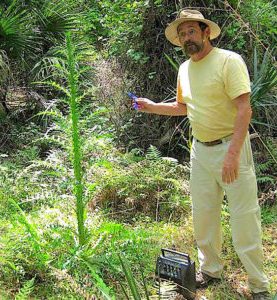
Both foraging classes this weekend are on Florida’s east coast and the presumption is both parks will be open following last week’s rain from Hurricane Dorian. Rain is expected this weekend but not enough to stop classes unless the parks are closed.
Saturday, September 14th, Wickham Park: 2500 Parkway Drive, Melbourne, FL 32935-2335. 9 a.m. to noon. Meet at the “dog park” inside the park.
Sunday September 15th, George LeStrange Preserve, 4911 Ralls Road, Fort Pierce, FL, 34981. 9 a.m. to noon. The preserve has no official bathroom or drinking water so take advantage of the various eateries and gas stations before arrival. You can walk your dog through the preserve.
Saturday, September 21st, Blanchard Park, 10501 Jay Blanchard Trail, Orlando, FL 32817. 9 a.m. to noon. Meet next to the tennis courts by the YMCA building.
Sunday September 22nd, Eagle Park Lake, 1800 Keene Road, Largo, FL 33771. 9 a.m. to noon. Meet at the pavilion near the dog park.
Saturday, September 28th, Florida State College, south campus, 11901 Beach Blvd., Jacksonville, 32246. 9 a.m. to noon. We will meet at building “D” next to the administration parking lot.
Sunday, September 29th, Bayshore Live Oak Park, Bayshore Drive. Port Charlotte. 9 a.m. to noon. Meet at the parking lot at the intersection of Bayshore Road and Ganyard Street. 9 a.m. to noon.
For more information about the classes, to sign up and or pay for a class go here.
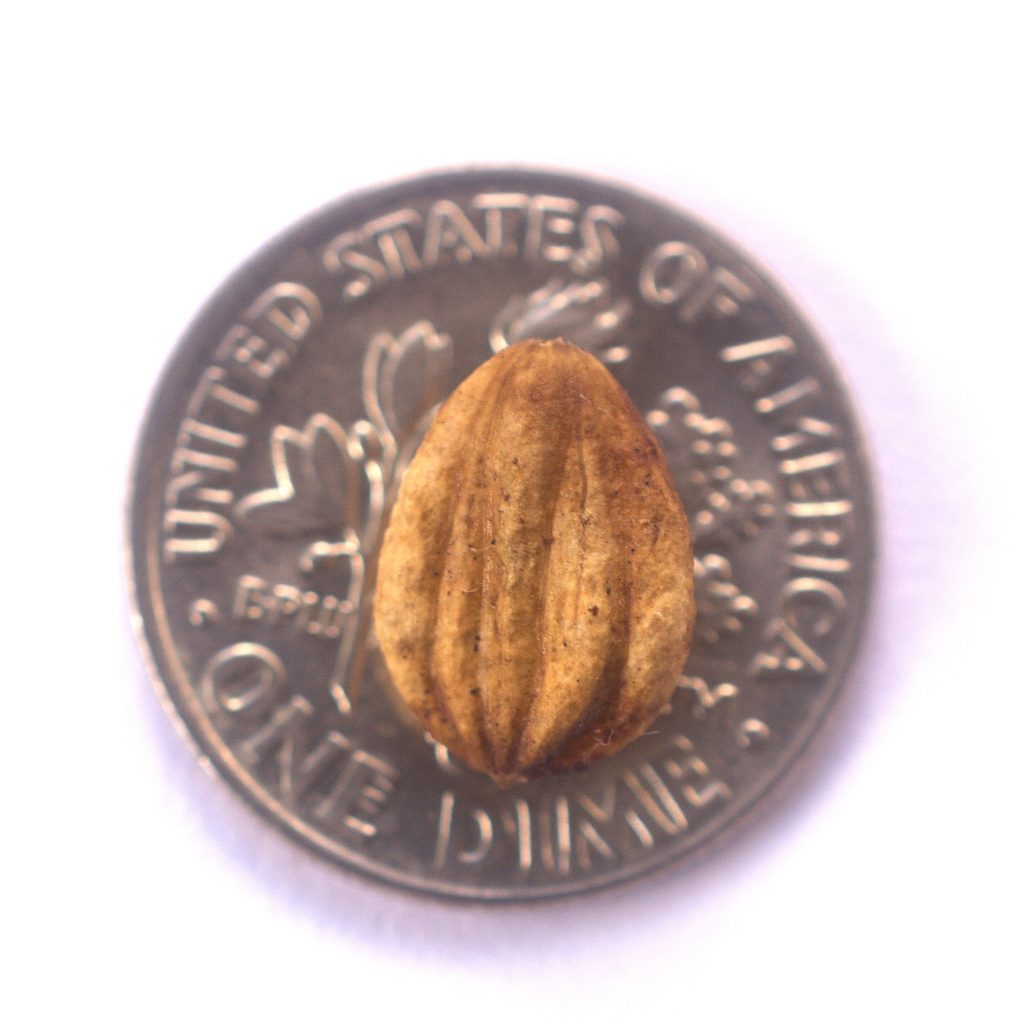
Do you know why the Sweet Gum tree is called “sweet?” Because it’s the least foul of all the “gum” trees. None have a great flavor regardless of what parts you might consume, be it the fruit or congealed sap. The Sweet Gum is not sweet. It’s just not as bad as the rest. And you can prove it yourself by trying some Black Gum fruit coming into season.
Also known as Black Tupelo, the fruit is sour and bitter, intensely so. I’ve only met one person who likes them right off the tree. Personally I think the fruit rightly reminds us of how desperately hungry people were in the past. To get around the taste — which has been compared to really bad manure — folks cooked it and added huge amounts of sugar. One good identification characteristic of the Black Gum fruit is the vertical striations on the seed. You can read about the Black Gum here. The Sweet Gum is here.
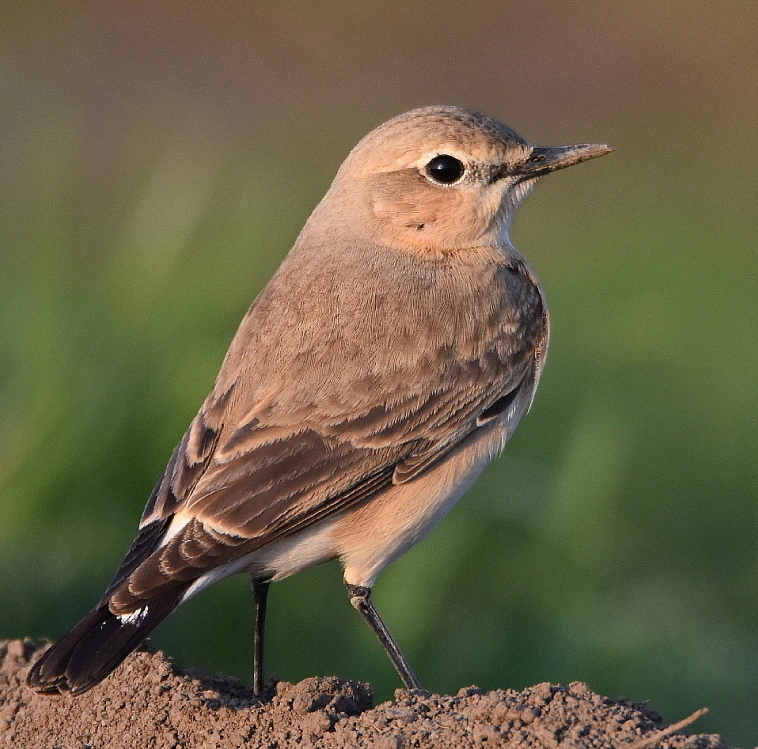
To my knowledge I’ve never met anyone named Isabell. So when the word “isabelline” cross my optical path about plants I had to look into it. “Isabell” means “God’s promise” presumably a positive one. It was very popular girl’s name in the 1880s, all but disappear until 2003 whereupon it had a resurgence in popularity until 2007. Now it is on the wane again. But what is isabelline? There are three application of which I have also apparently never heard of. One is what we could call Spanish Gothic Architecture. King and queen Ferdinand and Isabella got Columbus launched then turned to building cathedrals and the like. That style is called Isabelline, properly capitalized. I’m surprised they didn’t called it Ferdinine. The second use is a color: Isabelline. A color? Yes, and the word has been in use for at least 400 years so it is not a paint-store invention like “Baby Fawn.”
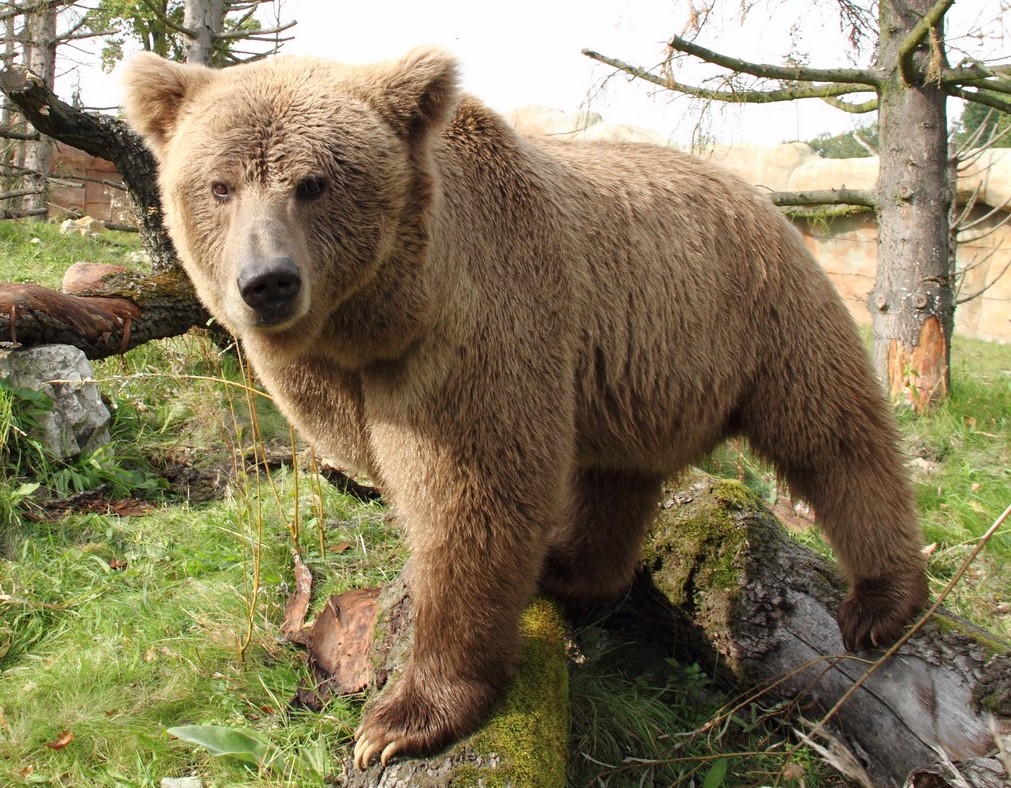
Isabelline means a light yellow-gray and used mostly to describe mushrooms, animals and birds. There is the Isabelline Wheateater, see above left, the Isabelline Shrike, and the Isabelline Bear, right. Horses that are a cross between a Golden Palomino and a Champagne Palomino are also called Isabelline. Now, what of the third use? Well… ahem….Isabelline is also a reference to faded underwear. The story comes from when Philip II of Spain laid siege to the berg of Ostend in 1601. His daughter, Isabella, Archduchess of Austria, made a rather presumptuous vow not to change her underwear until the city was taken, thinking dad would be home by supper, lunch by Sunday for sure… Unfortunately for Isabell — and those around her — the siege took three years. Thus the color of dingy underwear is isabelline.
The weekend could have been worse. Friday my Miata failed to start. That’s the bad news. The good news is it was in my driveway at the time, not the other end of the state. Predictions were it was a major mechanical catastrophe. Saturday’s class was local so I drove my van. Sunday’s class was south of St. Pete so I rode 256 miles on my motorcycle to make that class. That left Monday. I had to give a presentation Monday evening to the Manatee Rare Fruit Council, a 273-mile motorcycle ride in afternoon heat, I-4 traffic, and then dark of night. Fortunately the Miata’s issue was small and repaired just in time to drive to Palmetto. (And then unpredicted thunderstorms fumed so at least on the late-night drive back I was dry not wet, tired and miserable.) The talk went well — I thank the council for inviting me, click on their link upper left — and I saw Andy Firk there. He generously gave me a copy of the Bessette’s newest publication: Mushroom of the Gulf Coast States.
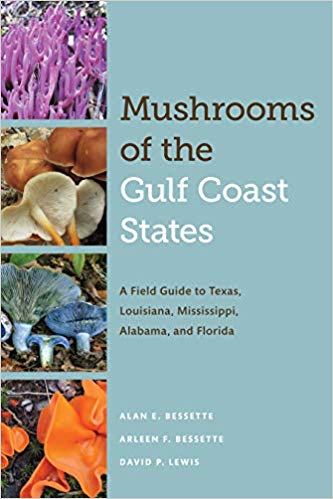
At 614- pages Mushrooms of the Gulf Coast States is a good addition to your library and area of study. The South has notorious problems with mushroom identification. It’s just not like the rest of North America nor Europe. Add to that revisionary DNA testing and, to mangle some metaphors, the fog gets muddier. There are huge naming and identification issues. Through this mushroom morass the Bessettes — Allan and Arleen with co-author David P. Lewis — keep clarifying and updating. It sometimes takes them weeks to identify a mushroom. And it has to be frustrating to finally figure out what you have only to learn the name has been change (because it had a European-based name) and or has not been renamed or one totally as-of-yet reported… the fungi world is in flux. Publication of the Mushrooms of the Gulf Coast States is timely. The book covers over 1,000 common and less-known species in Texas, Louisiana, Mississippi, Alabama, and Florida. The fungi themselves are broken down in to major groups and are color-keyed. From description to cooking instructions (for the edible ones) the book is brimming with helpful information.

Donations to upgrade: If you’d like to donate to this website and newsletter you can use this Go Fund Me link, this PayPal donation link or by writing to Green Deane POB 941793 Maitland FL, 32794. And I am in the process of writing to folks who are interested in exchanging some webmastering for foraging classes. As they used to say when we had television with antennas, stay tuned.
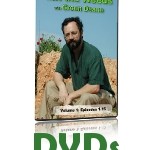
All My Videos are available for free on You Tube. They do have ads on them so every time you watch a Green Deane video I get a quarter of one cent. Four views, one cent. Not exactly a large money-maker but it helps pays for this newsletter. If you want to see the videos without ads and some in slightly better quality you can order the DVD set. It is nine DVDs with 15 videos on each for a total of 135 videos. Many people want their own copy of the videos or they have a slow service and its easier to order then to watch them on-line. The DVDs make a good gift for that forager you know especially as spring is … springing. Individual DVDs can also be ordered or you can pick and choose. You can order them by clicking on the button on the top right hand side of this page (if your window is open wide enough.) Or you can go here.
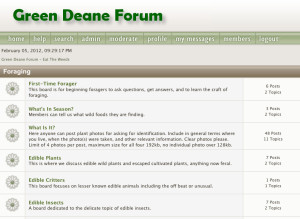
Want to identify a plant? Perhaps you’re looking for a foraging reference? You might have a UFO, an Unidentified Flowering Object you want identified. On the Green Deane Forum we — including Green Deane and some 8,000 others from around the world — chat about foraging all year. And it’s not just about warm-weather plants or just North American flora. Many nations share common weeds so there’s a lot to talk about. There’s also more than weeds. The reference section has information for foraging around the world. There are also articles on food preservation, and forgotten skills from making bows to fermenting food.
This is weekly newsletter 372. If you want to subscribe to this free newsletter you can find the sign-up form in the menu at the top of the page.

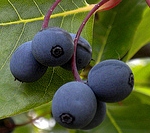


A possible reason for not foraging near roads is because of the possibility (if foraged A LOT) of contamination with lead, both from fumes and from particulate matter.
Thank you for the recommendation on Mushrooms of the Gulf Coast States.